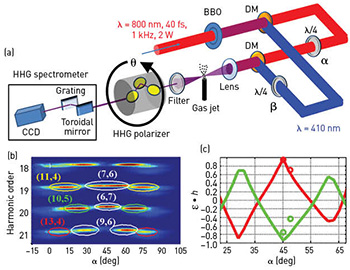 (a) Experimental setup. Polarizations of bichromatic drivers (centered at 800 nm and 410 nm) are controlled by two quarter-waveplates (α and β). DM: dichroic mirror. (b) Experimental HHG spectra versus harmonic order and waveplate angle (α), where the 410 nm driver is held right-circularly polarized. Harmonics are labeled by a pair of integers [e.g., harmonic 19.65 by (6,7)] indicating the number of annihilated red and blue photons, respectively, according to conservation of energy. (c) Ellipticity–helicity product of the (7,6) harmonic channel (red) and the (6,7) channel (green), as measured (circles) and numerically calculated (curve).
(a) Experimental setup. Polarizations of bichromatic drivers (centered at 800 nm and 410 nm) are controlled by two quarter-waveplates (α and β). DM: dichroic mirror. (b) Experimental HHG spectra versus harmonic order and waveplate angle (α), where the 410 nm driver is held right-circularly polarized. Harmonics are labeled by a pair of integers [e.g., harmonic 19.65 by (6,7)] indicating the number of annihilated red and blue photons, respectively, according to conservation of energy. (c) Ellipticity–helicity product of the (7,6) harmonic channel (red) and the (6,7) channel (green), as measured (circles) and numerically calculated (curve).
Extreme UV (XUV) and X-ray tabletop light sources based on high-harmonic generation (HHG) exhibit unique and controllable features, such as attosecond timescale pulses and broad tunable bandwidth. Yet one fundamental property of these sources has remained largely uncontrollable: their polarization. Changing the polarization of visible light is as simple as rotating a waveplate; for the XUV and X-ray spectral regions, by contrast, waveplates are very lossy and spectrally limited.
Hence, the ability to control the polarization of HHG-based sources at the generation step is highly desirable, and numerous techniques have been proposed for HHG with elliptical and particularly circular polarizations. Experimentally, however, polarization of HHG, especially of bright harmonics, has been largely limited to linear polarization. We have now demonstrated HHG with fully controllable polarization—from linear through elliptic to circular—without compromising the efficiency of the process.1
Our approach is based on mixing of spins, the radiation angular momentum associated with polarization and conserved in harmonic generation from an isotropic medium. For example, high-harmonics with left-circular polarization are produced when m left-circular-polarized driver photons, at frequency ω1, and m−1 right-circular-polarized driver photons, at frequency ω2, are converted into an HHG photon at frequency mω1 + (m−1)ω2 (according to conservation of energy) and spin mℏ – (m–1)ℏ = ℏ (according to conservation of spin angular momentum).2
By delicately controlling the polarization of one of the drivers (by rotating a waveplate), we obtained full control over the ellipticity of the harmonics. That is, changing the polarization of a HHG-based source is in fact as simple as rotating a waveplate. In addition, using drivers with incommensurate frequencies, we identified the number of photons that each driver contributes to the generation of every harmonic order. We have employed this finding to show that varying the ellipticity of a driver beam leads to rich selection rules that qualitatively correspond to conservation of spin angular momentum.1,3
This work paves the way for new research directions and applications, including ultrafast XUV and X-ray circular dichroism of magnetic films and the synthesis of bright chiral attosecond pulses from harmonics of specific helicity, as with helicity-selected phase matching.4
Researchers
Avner Fleischer, Technion, Haifa, Israel, and Ort Braude, Karmiel, Israel
Ofer Kfir, Tzvi Diskin, Pavel Sidorenko and Oren Cohen, Technion, Haifa, Israel
References
1. A. Fleischer et al. Nat. Photon. 8, 543 (2014).
2. S. Long et al. Phys. Rev. A 52, 2262 (1995).
3. E. Pisanty et al. https://arxiv.org/abs/1404.6242 (2014).
4. O. Kfir et al. https://arxiv.org/abs/1401.4101 (2014).
